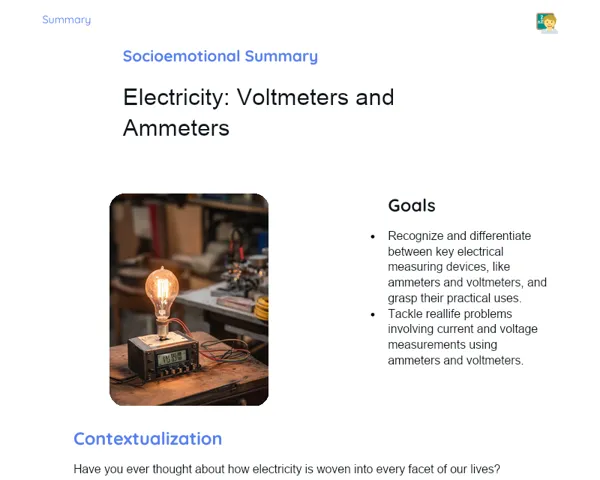Summary Tradisional | Electricity: Series Resistors
Contextualization
Electricity plays a vital role in our daily lives, powering everything from our gadgets to the lights in our homes. At the core of many electrical circuits are resistors, which are components that help regulate the flow of electric current. When resistors are arranged in series—one after another in a single line—they form a foundational setup for grasping more complicated electrical circuits.
In a series arrangement, the electric current passing through each resistor remains constant, while the total voltage across the circuit gets divided among the resistors. This configuration is essential for various practical uses, such as in devices that measure voltage and control lighting circuits. Understanding how to compute the equivalent resistance in a series circuit, which is simply the total of all individual resistances, is crucial for tackling practical challenges and designing effective electrical circuits.
To Remember!
Concept of Series Resistors
In series circuits, resistors are linked up one after the other in a straight line. This placement ensures that the electric current flowing through each resistor remains the same, as there are no branches in the circuit to divert the current. As a result, the current runs directly through each resistor.
Each resistor adds to the overall resistance of the circuit. The total voltage supplied to the circuit divides among the resistors based on their individual resistances. Hence, the cumulative voltage drops across each resistor equals the total voltage supplied to the circuit. This concept is fundamental for analyzing and understanding more intricate electrical circuits.
Grasping the idea of series resistors is vital for solving real-world problems and designing effective electrical circuits. You'll find this concept frequently applied in everyday scenarios like voltage measuring devices and lighting control systems, where managing the current through electrical components is necessary.
-
Series resistors are arranged one after the other in a straight line.
-
The electric current through each resistor remains constant.
-
The total voltage across the circuit divides among the resistors.
Equivalent Resistance Formula
The equivalent resistance (R_eq) of a circuit featuring series resistors equals the sum of the individual resistances. It can be summarized by the formula: R_eq = R1 + R2 + R3 + ... + Rn, where R1, R2, R3, and so forth represent the individual resistances. This equivalent resistance indicates the cumulative resistance that the electric current encounters as it flows through the circuit.
This formula is essential for determining the total resistance in circuits using series resistors. Understanding the equivalent resistance helps in calculating the overall current in the circuit when a certain voltage is applied. Moreover, this knowledge is crucial for analyzing and designing electrical circuits, allowing for fine-tuning the total resistance when needed.
Mastering the equivalent resistance formula is a going skill for addressing practical electricity issues. For example, in a lighting circuit, calculating the equivalent resistance is necessary to ensure that the current is appropriate for the safe and efficient functioning of bulbs.
-
The equivalent resistance equals the sum of individual resistances.
-
The formula is R_eq = R1 + R2 + R3 + ... + Rn.
-
It is used to calculate total resistance in series circuits.
Practical Examples
To illustrate series resistors and the equivalent resistance formula, consider a circuit with three series resistors having resistances of 4 Ω, 6 Ω, and 10 Ω. Here, the equivalent resistance is calculated as follows: R_eq = 4 Ω + 6 Ω + 10 Ω = 20 Ω. This shows that the total resistance faced by the electric current in the circuit is 20 Ω.
Another practical instance is finding the current in a series circuit. If the equivalent resistance of a circuit is 20 Ω and a voltage of 10 V is applied, we can utilize Ohm's Law (V = I * R) to determine the current (I) through rearranging the formula to I = V / R. Therefore, I = 10 V / 20 Ω = 0.5 A, indicating that the current flowing through the circuit is 0.5 A.
These practical examples are helpful in understanding how theoretical concepts translate into real-world applications. They help reinforce knowledge of series resistors and the equivalent resistance formula, aiding in comprehension and problem-solving in electrical circuits.
-
Example of calculating equivalent resistance: R_eq = 4 Ω + 6 Ω + 10 Ω = 20 Ω.
-
Calculate current using Ohm's Law: I = 10 V / 20 Ω = 0.5 A.
-
Practical examples solidify understanding and application of theoretical concepts.
Everyday Applications
Series resistors find numerous practical applications in day-to-day life. A common illustration is in lighting circuits, like Christmas fairy lights. If one bulb malfunctions, the entire circuit goes off, effectively showcasing the concept of series resistors. This occurs because the electric current can't pass through the nonworking resistor, halting the current flow throughout the circuit.
Another example is in voltage measuring instruments, where series resistors are utilized to split the voltage applied. This allows for accurate voltage readings at various points in the circuit. Series resistors also feature in lighting control circuits to manage the current flowing to the bulbs, ensuring they function safely and effectively.
Understanding these everyday applications is key to contextualizing the study of series resistors, highlighting their significance and utility in practical situations. Being aware of how to apply theoretical principles in real-life contexts is vital for building problem-solving capabilities and designing efficient, safe electrical circuits.
-
Series resistors are employed in lighting setups, like Christmas lights.
-
They assist in voltage measuring devices for voltage division.
-
They control current flow within lighting systems.
Key Terms
-
Series Resistors: Components arranged in a single line, where the electric current through each remains identical.
-
Equivalent Resistance: The total of individual resistances in a series circuit.
-
Ohm's Law: The relationship between voltage, current, and resistance, expressed as V = I * R.
-
Voltage Drop: The difference in voltage between two points in an electrical circuit.
-
Electric Current: The flow of electric charge moving through a specific point in an electrical circuit.
Important Conclusions
In our lesson, we explored the concept of series resistors, where they connect in a single line, ensuring the electric current through each is the same. We also learned how to compute equivalent resistance by adding up the individual resistances, and recognized that this formula is integral to analyzing and designing electrical circuits.
Furthermore, we tackled practical examples that illustrated how to calculate both equivalent resistance and current in series circuits. These real-world examples play a crucial role in solidifying our theoretical understanding, allowing us to effectively apply this knowledge in scenarios like lighting circuits and voltage measuring devices.
Grasping the concept of series resistors is essential for comprehending more advanced electrical circuits and their applications in our daily lives. Knowing how to calculate equivalent resistance and electric current is pivotal for creating efficient and safe circuits, which are necessary for the proper functioning of various electronic devices we use every day.
Study Tips
-
Review the key concepts and formulas regarding series resistors to ensure clarity on calculating equivalent resistance and electric current.
-
Practice solving electrical circuit problems involving series resistors while varying resistance and voltage values for better problem-solving skills.
-
Investigate and examine the practical uses of series resistors in daily life, such as in lighting circuits and electronic products, to deepen contextual knowledge of the subject.



